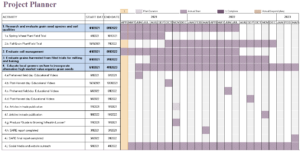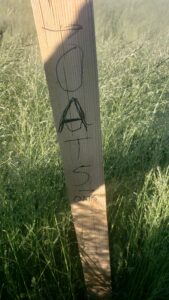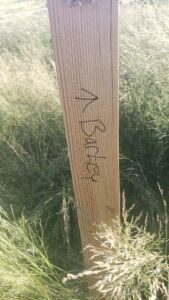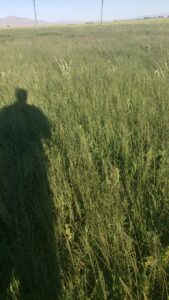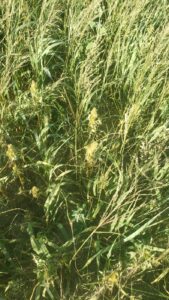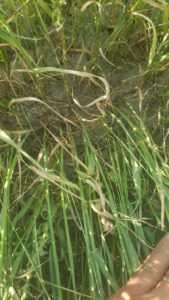Final report for FW21-376
Project Information
For decades in Lassen County, California the primary agricultural product produced by farmers in the region has been alfalfa rations intended for dairy farmers. Alfalfa has consistently done well in the dry, high-altitude climate of Northeastern California. However, demand from dairy farmers has steadily decreased due to multiple factors which have resulted in economic challenges for Lassen County growers. Thomas Traphagan, owner of Sunset Ranch, will conduct a field research study to identify an alternative crop for human consumption that could improve profits for Lassen County farmers and provide a high-value direct to consumer product. The research project will focus on four objectives including:
1) Evaluating the performance six grain seed species for the soil and climate of Lassen County; 2) Developing recommendations for optimal organic soil management and irrigation management to incorporate top performing grain crops well-suited for the region.
3) Evaluate the unique the flour and baking qualities of these grains.
4) Educate local growers through multiple outreach activities to encourage the adoption of these recommendations to improve the economic conditions in Lassen County.
This data does not currently exist for the Lassen County region and the results of this research project could provide valuable and actionable information for farmers to adopt the recommendations and produce a new, organic primary crop in an environmentally sustainable way and improve economic conditions for local growers.
- Evaluate six grain seed species and varieties and identifying the top performing grain seed for Lassen County. Varieties include Durum wheat, oats and barley.
- Assess the optimal organic fertility management, irrigation management, and nutrition budget needs for grain seeds suited for Lassen County’s climate and soil composition.
- Research six grain seed species and varieties’ flour and baking qualities.
- Educate local growers on how to incorporate alternative high-market value organic grain seeds for human consumption into their practice to improve profitability and stewardship of natural resources.
Cooperators
- - Technical Advisor
- - Producer
Research
Research Objectives:
- Research and evaluate the quality of grain seed varieties that will thrive in the Lassen Country climate by planting six, 10 acre test plots for six varieties of Durum wheat, barley and oats. Upon harvest these grain seed varieties will be evaluated for their Protein Percentage, Moisture Percentage, Test Weight (lbs./bushel) and Pounds per Acre. UPDATE:
As previously mentioned, due to the wildfires we missed the Spring 2021 growing window and were not able to evaluate the quality of the grain seeds according to our original timeline. We were granted a one-year extension and planned to test Oats, Barley, and Durum as well as the spring and fall mixes. These mixes were comprised of the same species of grain but with different qualities. This was hoped to allow us to test the backing qualities of these grains. Revised timeframe moved all original milestones out one year and included a Spring 2022 test plot and a Fall 2022 test plot under pivot irrigation.
- Construct and encourage a certified California Department of Food and Agriculture Organic planting soil development and fertilization plan for successful grain seed varieties geared for human consumption specific to the region of Lassen County’s climate, soil, irrigation and organic fertility management needs. To do this we will research and conduct soil analysis measuring the nitrogen, phosphorus and potassium levels of the test plots in order to determine optimal nutrient budget for planting in Lassen County.[1] The gallons of water per acre for irrigation purposes will also be measured for the test plots and compared to water requirements for alfalfa. UPDATE:
Unfortunately, as outlined above we have not been able to complete this due to the initial delay. We were able to complete the cover crop and then dumped manure and nitrogen for the 2021 spring field trial which was not successful due to irrigation challenges related to the wildfires. The Spring 2022 and Fall 2022 test plots also utilized organic growing techniques and fertilization. These subsequent plots utilized nitrogen and composed chicken and cow manure and were irrigated using pivots.
- Evaluate the suitability of field tested grain seed varieties for milling and baking which can be successfully marketed to consumers. The variations selected will be chosen for serving as pancake mix, bread mixes and basic flour mixes. Testing will be completed in coordination with the California Wheat Commission. To determine flour quality we will measure: Flour Yield Percentage, Moisture Percentage, Ash Content and Milling Score. In addition we will also evaluate the Mixograph qualities of the filed trial seed grains by measuring the Absorption Percentage, Mixing Peak Time (Mins); Mixing Peak Height (M.U.). We will also evaluate the following bread qualities: Baking (abs %), Mix Time (Mins); Volume (cc); Dough Handling (1-10), Crumb Texture (1-10) and Bread Symmetry (1-10).[2]UPDATE: As outlined above we were not able to plant the crop nor obtain the product for evaluation in 2021. We were able to plan Spring 2022 and Fall 2022 test plots but were unable to harvest and evaluate the properties of the grains.
The results of this research study will produce locally derived data that can inform our own practice and other growers in Lassen County of species and varieties of grain seeds that are both well-adapted, high yielding and produce quality organic grain intended for human consumption. We anticipate a profitable benefit for the current alfalfa producers and beginning farmers in Lassen County residing in the Northern California region. With only a handful of large scale producers of alfalfa we estimate the small and midsize producers to find benefit in the transition from alfalfa to an added value crop desired for human consumption and favored by the current market.
UPDATE:
As outlined above we were delayed by circumstances and forces beyond our control in 2021 and 2022 test plots were not viable due to influx of weeds.
[1] UCDAVIS Plant Tissue Sampling. Accessed on 10/23/2020. At:
http://geisseler.ucdavis.edu/Guidelines/Plant_Tissue_Sampling.pdf
[2] Agronomy Research & Information Center Small Grains. Accessed on 10/23/2020. At: http://smallgrains.ucanr.edu/Annual_Variety_Results/Common_Wheat_Quality_2019/
We did fertilize the 2021 spring field trial plots with nitrogen, gypsum and chicken manure. We were able to do a visual evaluation of the soil however, as mentioned due to the wildfires and government officials delaying the installation of new electrical system to service the irrigation system for these test plots, we missed the growing season for spring 2021. Seeds were left dormmate in hopes that watering them in the spring 2022 would allow us to save the crop. Unfortunately, visual inspection of the pots revealed large amounts of weeds growing with the grain varieties. This made the crop unviable from a study perspective. To complete this study, we planned to conduct a new spring field trial to be planted in June in 2022 and plant another field in September for a fall in 2022. This will push our timeframe out by one year to complete all of the objectives we outlined in the project, and we received a one-year extension. In June 2022, a new Spring test plot was identified under pivot irrigation. The plot was heavily fertilized with nitrogen and composted chicken and cow manure at a rate of four tons of manure. Plot was field prepped and heavily planted with the assortments of oats and barley, knowing that irrigation, and fertilizer was available in abundance. This was all done under organic practices and no herbicides were used to control the weeds. In Fall 2022 we completed another set of test plots under pivot irrigation, with heavy nitrogen and composted chicken and cow manure and followed the organic growing technique of heavy planting to crowd out any weeds. Soil analysis of the test plots indicated that the nitrogen level after fertilization was 90 pounds per acre prior to planting.
Results from the Spring 2022 and Fall 2022 tests plots indicated that all of the grain varieties sprout and come up. However, both test plots experienced a significant influx of weeds that took over the growth pattern of the grains which were overwhelmed. We had overplanted the feeding plot hoping to overtake the weeds which is an organic growing technique. The planting rate for both trials was high at 150 pounds of seed per acre. We utilized a standard variety of oat and barley that was feed quality. The water applied to both test plots for fall and spring 2022 were the same at 1-and-a-half-acre foot of water per day. This is the same watering rate as alfalfa. For both test plots the grain varieties did germinate. Unfortunately, the weeds grew faster than the grain. Final assessment revealed that that after struggling with the weeds only 15% of the grain varieties came up above the weeds. Completing a dry down of the plots before harvest would have made the weeds even worse. Due to this we were unable to combine the test plots to harvest the grain. This production rate of only 15% per acer would not make the organic grain varieties a viable crop utilizing the organic technique that was utilized. We did note one benefit of the fall planting required less water and represented one benefit over the spring planting. However, both fall and spring planting seasons gave time for the weeds to grow more aggressively.
Conventional growing techniques, utilizing similar fertilization and planting techniques, coupled with the use of herbicides for weed control would likely be effective. We will ultimately try another experiment independently of this grant project focused on the organic planting techniques of barley which would probably do better in alkaline soil.
Thomas Traphagan video assessing results of the test plots from 2022: Verizon Message+ for Hi-Res Videos (vzmessages.com)
2022 Annual Updates:
Timeline Activities
1. Research and evaluate grain seed species and soil qualities
1a. Spring wheat plant field trial:
As originally planned, we did commence the project by planting a spring wheat trial of six varieties including Durham, Barley, and Oats on three 10-acer plots and a spring six of three different varieties on a 15-acer plot. This included fertilizing the areas with nitrogen, gypsum, and chicken manure. Plans included the installation of irrigation equipment for these test plots which required new electrical installation. Unfortunately, after the plots were fertilized and planted, there were a series of wildfires in the county and by order of local officials, the electrical system was not allowed to be activated. Our Technical Advisor, David Lile, of the University of California Davis can provide additional details regarding the serious wildfires that were affecting the region during this time if needed. This uncontrollable delay resulted in us missing the spring wheat growing window. The seeds were left dormmate in the plots in hopes that the following year, during the spring 2022 season the crop could be watered and grown. Unfortunately, after recent evaluation of the originally planted test plots there were significant number of weeds growing throughout the testing plots which compromised the integrity of this crop and would make it difficult to complete the evaluation. To complete the project study supported by the grant our revised plan was to plant and evaluate the six different wheat species on 2-3 acer plots underneath existing irrigation pivots for the spring 2022 planting season and then do a Fall 2022 planting season thereafter. We received an extension for the grant but as outlined above the Spring 2022 crop was not viable due to weeds. To complete the project study supported by the grant our revised plan was to plant and evaluate the six different wheat species on 2-3 acer plots underneath existing irrigation pivots for the spring 2022 planting season and then do a Fall 2022 planting season thereafter. We received an extension for the grant but as outlined above the Spring 2022 crop was not viable due to weeds.
1.b. Fall Grain plant field trial
Unfortunately, this objective was delayed due to the fires that prevented and delayed the 2021 spring Wheat Field Trial. The spring and fall plant should happen in succession to afford a valuable study and comparison of results. We plan to follow our objectives and plant a 2022 fall grain plant field trial. Crops from test plots in 2021 and 2022 were not viable and we were unable to evaluate the baking qualities of the grains.
2. Evaluate soil management
We did fertilize the 2021 spring field trial plots with nitrogen, gypsum and chicken manure and do a visual evaluation of the soil. As outlined above in the Spring and Fall 2022 test plots we were able to fertilize and prepare the fields under pivot irrigation.
3. Evaluate grains harvested from field trials for milling and baking
We have not been able to evaluate the grains harvested for milling and baking qualities. This is due to the failure of the 2021 spring field trial. Grains harvested from the revised timeline for the 2022 spring and 2022 fall field trials will be evaluated as described in grant proposal post-harvest. UPDATE: Crops from test plots in 2021 and 2022 were not viable and we were unable to evaluate the baking qualities of the grains.
4. Educate local growers on how to incorporate alternative high-market value organic grain seeds
4a. Pre-harvest field fay educational videos (2021)
As previously detailed, we were unable to grow the 2021 or the 2022 spring and fall field trials and were not able to complete pre-harvest field day educational videos. Education was provided to local farmers at an educational event hosted at Benson’s Humble Homestead in Janesville, California in the Spring of 2023.
4b. Post-harvest field day educational videos (2021)
As previously detailed, we were unable to grow the 2021 or the 2022 spring and fall field trials and were not able to complete post-harvest field day educational videos. Education was provided to local farmers at an educational event hosted at Benson’s Humble Homestead in Janesville, California in Spring of 2023.
4e. Articles in trade publication (2021)
As previously detailed, we were unable to have a successful harvest for both the 2021 or the 2022 spring and fall field trials and were not able to complete pre-harvest field day educational videos. Education was provided to local farmers at an educational event hosted at Benson’s Humble Homestead in Janesville, California in Spring of 2023.
4g. Produce * Guide to Growing Wheat in Lassen*
As previously detailed, due to the failure of the 2022, crop was not able to summarize our findings into growing recommendations at this point. The organic growing technique utilized did not yield a successful crop. Conventional growing methods utilizing herbicides would have been able to produce those grain varieties.
4j. Social media and website outreach
At this point we were not able to complete the social media and website outreach with findings, videos or links to publications due to the delays already detailed. The only activity was that Andrea Traphagan posted on Facebook the Alturas School District education event.
|
Timeframe Chart |
Start Date |
End Date |
|
1. Research and evaluate grain seed species and soil qualities |
4/1/2021 |
8/1/2022 |
|
1.a. Spring Wheat Plant Field Trial (June 22) |
6/1/2022 |
10/1/2022 |
|
2.b. Fall Grain Plant Field Trial (Sep Oct 22) |
10/15/2022 |
7/1/2023 |
|
2. Evaluate soil management (June 22-Octo) |
6/1/2022 |
8/1/2023 |
|
3. Evaluate grains harvested from filed trials for milling and baking Aug 22- July 2023 |
8/1/2022 |
7/1/2023 |
|
4. Educate local growers on how to incorporate alternative high-market value organic grain seeds - Go one year out. |
7/1/2022 |
11/1/2023 |
|
4.a Preharvest field day Educational Videos |
7/1/2022 |
7/1/2022 |
|
4.b. Post-Harvest day Educational Videos |
10/31/2022 |
10/31/2022 |
|
4.c. Preharvest field day Educational Videos |
6/1/2023 |
6/1/2023 |
|
4.d. Post-Harvest day Educational Videos |
9/1/2023 |
9/1/2023 |
|
4.e. Articles in trade publication |
11/1/2023 |
11/1/2023 |
|
4.f. Articles in trade publication |
11/1/2023 |
11/1/2023 |
|
4.g. Produce “Guide to Growing Wheat in Lassen” |
11/1/2023 |
11/1/2023 |
|
4.h. SARE report completed |
5/20/2022 |
5/20/2022 |
|
4.i. SARE final report completed |
3/1/2022 |
3/1/2022 |
|
4.j. Social Media and website outreach |
10/1/2022 |
4/1/2023 |
Budget Updates:
- During the COVID 19 Pandemic, the California Wheat Commission was not able to reopen these classes until the spring of 2022. To date we have not completed these lab training sessions and due to the failure of the Spring and Fall 2022 test plots we have not completed the training. We still plan to complete the training in the future, independent of this grant and research project.
- We were able to purchase the Year 1 tests including the grain tests and soil tests.
- We were also able to purchase some of the minor equipment, including probes, lab scale and other supplies.
- We did purchase the 3000 lbs of seed and the fertilizer for the 2021 Spring Field Trial.
- UPDATE since last report:
- We did purchase 3000 lbs of seed and fertilizer for the 2022 Spring Field Trial.
- We did purchase 3000 lbs of seed and fertilizer for the 2022 Fall Field Trial.
- Incurred costs for irrigation
Research Outcomes
Based on the results of this project, we would caution farmers in Lassen County when utilizing an organic growing plan due to the difficulty of weed control. It was impossible under those techniques to gather enough grains to make it profitable. Conventional growing techniques could be utilized to control weed growth and enable the harvest of barley.
Education and Outreach
Participation Summary:
This project required an electrical infrastructure connection to water the grains needed for the research project. Unfortunately, the electrical connection installation was delayed due to wildfires in the area. After connection was installed, electricity was turned off by California, state officials and we were unable to water the planted grains needed for this study. This delay resulted in missing the optimal growing time frame for last season. If we were to water so late in season the crop would have been wasted. We left seeds dormant and initiated watering this season April 20th, 2022. Educational activities included a May 9th, 2022, AG in the Classroom event in Alturas, California and we are expecting 22 classes to rotate through our booth to discuss wheat and our grant project.
We had also been working with local ag teachers and scheduled field trips of visiting student classes to educate on wheat growing and testing of types of grains being grown. Unfortunately, these field trips had to be rescheduled outside the window of this grant period. We did present our findings at an event set up by Benson’s Humble Homestead in the Spring of 2023 provided education on what we tried to do with the oats and the barely.
Other than the educational events previously mentioned, due to the fact that the organic growing techniques did yield a successful crop we have share our experiences but have not undertaken additional venues as we originally planned because we were expecting to have successful harvest and analysis of the soil and grains.
Education and Outreach Outcomes
Overall project outcomes from the failed 2021 spring crops and subsequent failures of the Spring 2022 and Fall 2022 identified the challenges of utilizing organic growing techniques in Lassen County, California. Fertilization technique and pivot irrigation did enable the various grain varieties to sprout. However, the influx of weeds proved the organic crops unviable utilizing the organic growing tehcnique. Conventional growing techniques and the use of herbicides likely would have allowed for harvest and evaluation of baking qualities. Due to the failure of the crops we were unable to complete an assessment of the environmental and economic benefits of our growing technic for farmers in Lassen County. We’ve shared our experience with local farmers and theorize that due to the alkaline soil of the area it would be difficult to make a profit off of organic growing techniques for oats. There is likely still potential with barley which tends to do better in alkaline soil. In addition, we also tested utilizing the burn process to burn the weeds and then plant but it resulted in strong weed activity.
